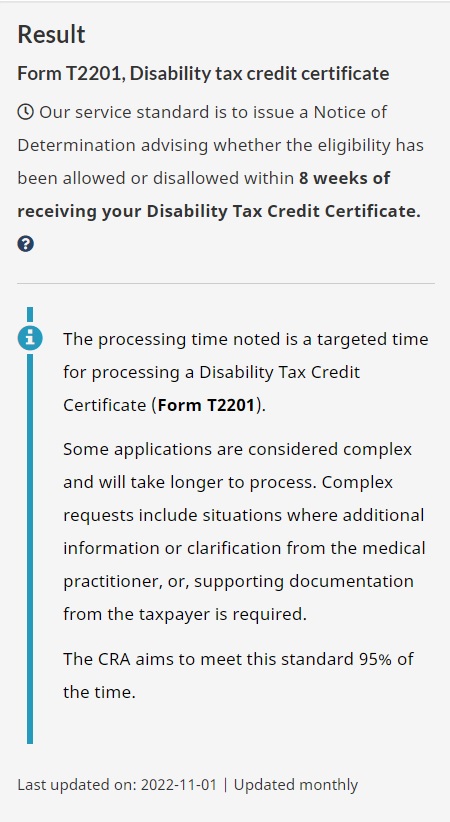Now that you’ve finally submitted your disability tax credit application, what’s next?
The first thing you should do is sit back and relax, as the process can take some time. The government will review your application and make a decision based on the information you and the medical practitioner provided.
I understand that if you haven’t gone through the process before, you may feel lost and confused. Therefore, I hope to give you a few pointers in this post.
After the disability tax credit application is submitted, the applicant should keep an eye on the “Notice of Determination.” Upon approval, you should request the CRA for any eligible T1 adjustment and look into other disability benefits that you may qualify for.
Here, you’ll learn the timeframe you can expect to hear from the CRA, the document you’ll receive from them, and the steps you should take after the DTC approval.
How long does it take CRA to process the disability tax credit application?

The CRA typically takes 8 weeks to process the disability tax credit application. That’s the timeframe CRA uses to assess the application in determining whether the applicant is eligible for the Disability Tax Credit (DTC).
Remember, you can submit the application online if you want to speed up the process. This will eliminate all unnecessary mailing.
I just spoke to a lady with a marked restriction on her mobility. She submitted the disability tax credit in June 2021 and got an approval notice from the CRA in about two months.
However, I’ve also heard from families, which took longer than that. The time frame really depends on the complexity of the application and whether you have provided all the necessary information for the CRA to make an assessment.
Furthermore, the processing time could vary depending on the time of the year. You may click here to check the CRA processing time.
What happens when you are approved for the disability tax credit?
After the CRA reviews the DTC application, they will send you a “Notice of Determination” with their approval decision.
Most of my clients received this letter by mail, but since we are moving into a digital era, I wouldn’t be surprised if the CRA would eventually just upload the letter to the online portal. So make sure you check your MyAccount as well.
A number of families have shown their letters to me. Usually, it would indicate the specific tax years you are eligible for the DTC. (i.e. from 20xx to 20xx)
Stay informed with our e-newsletter, where I share regular financial updates tailored specifically for Canadians with disabilities. Subscribe to stay ahead with financial insights that matter to you.
Let’s get some tax refunds from the DTC!

You may use the DTC to claim the disability amount on your income tax return. This can be applied to the years that you are eligible for, and the furthest you can backdate the disability tax credit is up to 10 years.
However, not everyone can backdate as far as 10 years. It also depends on when you were first diagnosed with the disability condition.
For example, the same lady I talked about earlier, her doctor diagnosed her condition 5 years ago. So the furthest she can backdate the DTC is 5 years.
Here are some ways to adjust your tax returns
When completing the t2201 form, if you have checked the option to automatically adjust your previous tax returns for all applicable years, then you are all set.
The CRA will either mail you a cheque or auto-deposit the money into your bank account. (But only if you have set up auto-deposit.)
However, if you didn’t select the option for the CRA to automatically adjust your tax, then you’ll need to notify them to do so.
I called the CRA, and there were several ways to do that. You can log in to MyAccount on the CRA portal and make the T1 adjustment for each eligible year.
Another way that an accountant shared with me is to send a letter to the CRA. In there, you can request them to apply the DTC to all the previous years that you are eligible for.
Of course, if you are not confident in doing that yourself, you can always hire an accountant to assist you.
How long does it take to receive the disability tax credit refunds?
It takes about 20 weeks for the CRA to process your T1 adjustment request and send you the DTC refunds.
Once again, you may click here to check the latest CRA processing time.
What happens if I have no income?
The DTC is a non-refundable tax credit. In other words, there will only be refunds if no income tax was paid in any previous eligible years.
I’ve also worked with many disabled people with very little income. So they transfer the unused portion of the DTC to their spouse or a family member that has taxable income. This way, they can receive some tax relief for supporting the disabled person.
Do you need to re-apply for the disability tax credit?
On the “Notice of Determination,” if it states that the DTC is only eligible for specific tax years, then you’ll need to re-apply when it expires. Many families that I’ve come across would need to re-apply every 10 years.
But there are also some families where the disability condition is considered to be permanent. In those cases, they don’t need to re-apply.
So it hugely depends on the medical practitioner’s diagnosis and whether the CRA thinks the disability condition has a chance to improve over time.
Tip: If you really need to re-apply, it’s better to start preparing a few months before the DTC expires since it could take some time to book an appointment and complete the T2201 form with your medical practitioner.
Look into other disability benefits
The disability tax credit could be a gateway to many other disability benefit programs. Once it is approved, you may look into the following:
- Registered Disability Savings Plan
- Child Disability Benefits
- Canada Pension Plan disability benefits
We just covered the scenario that the Disability Tax Credit approved, but what if it was declined? Here’s another post covering the options you could take in that case.
Curious about whether we’re the right fit for your RDSP planning? Let’s schedule a preliminary online meeting to discuss your financial needs. This will give you a clearer understanding into our client-focused approach. To get started, just drop me an email at Samuel@SamuelConsultant.com
Reference:
- Canada.ca – Disability Tax Credit (source)
Disclaimer:
The comments contained herein are a general discussion of certain issues intended as general information only and should not be relied upon as investment, financial, legal, accounting or tax advice. Please obtain independent professional advice, in the context of your particular circumstances. This newsletter was written, designed and produced by Samuel Li for the benefit of Samuel who is Advisors at : SamuelConsultant.com is a registered trade name with Investia Financial Services Inc., and does not necessarily reflect the opinion of Investia Financial Services Inc. The information contained in this article comes from sources we believe reliable, but we cannot guarantee its accuracy or reliability. The opinions expressed are based on an analysis and interpretation dating from the date of publication and are subject to change without notice. Furthermore, they do not constitute an offer or solicitation to buy or sell any securities.
Mutual Funds, approved exempt market products and/or exchange traded funds are offered through Investia Financial Services Inc.
Commissions, trailing commissions, management fees and expenses all may be associated with mutual fund investments. Please read the simplified prospectus before investing. Mutual funds are not guaranteed and are not covered by the Canada Deposit Insurance Corporation or by any other government deposit insurer. There can be no assurances that the fund will be able to maintain its net asset value per security at a constant amount or that the full amount of your investment in the fund will be returned to you. Fund values change frequently and past performance may not be repeated. Investia is not liable and/or responsible for any non mutual fund related business and/or services.

